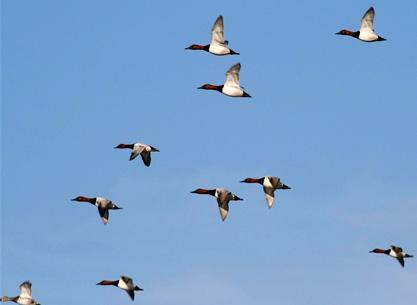


Longer focal lengths will give you less depth of field at the same aperture. Recommended setting: Aperture f/4 to f/8, depending on your focal length. Going in tight or showing a slightly wider view may work but really depends on the situation. It is important to focus on the bird that is the anomaly and have enough depth of field to let the other species surrounding it be identifiable. Finding a Wood Duck amongst Mallards, for example, makes for a great juxtaposition. This allows photographers to look for situations that show off the contrast between them. It is not uncommon for different species of ducks to winter together. It would not hurt to use a faster shutter speed as you do not want the birds to be blurry if they move. If the birds are somewhat static or moving slowly, shutter speeds of at least 1/500 th of a second are recommended. Recommended setting: Aperture f/5.6 or a stop down to get more depth of field. If you can find them in pools of water on the ice, even better. Ideally, you want to focus on the ducks that are closest to you and wait for at least one of them to make eye contact with the camera. Look for ducks on the edge of the ice with calm water in front of them. These conditions provide a great opportunity for capturing a flock’s reflection.

But ducks will often keep part of the water from freezing by constantly moving around. In the winter, if the temperature is cold enough, ponds and other bodies of water may ice up. The effort is well worth it, however. I have spent the past decade experimenting with different techniques for photographing flocks of ducks and waterfowl. Here are four hard-earned tips for turning groups of birds into compelling scenes. Photographers often look for individual birds to get a cleaner look to their images it is far more difficult to capture photos of flocks that appear orderly. Such groups are a treat for birders and photographers alike, but for the latter, they also present a challenge and an opportunity. Some species gather in small flocks while others can gather in “rafts” of thousands. However one threat to their populations includes hybridization with other ducks.If you've spent any time around water during fall or winter, you might have noticed that ducks are quite social. Most mallard species are common and not considered threatened. Mallards are territorial during much of this period, but once incubation is well underway, males abandon the nest and join a flock of other males. They normally lay about a dozen eggs, and the incubation period lasts just under a month. Mated pairs migrate to and breed in the northern parts of their range and build nests on the ground or in a protected cavity. They also graze on land, feeding on grains and plants. They rarely dive though, spending their time near the surface and dabbling for invertebrates, fish, amphibians, and a variety of plants. Mallard groups can often be seen head dipping or completely upending in the water. They grow to about 26 inches in length and can weigh up to 3 pounds.
#Flocks of mallards Patch
Females are mottled drab brown in color, but sport iridescent purple-blue wing feathers that are visible as a patch on their sides. Its iconic green head sits atop a white neckband that sets off a chestnut-colored chest and gray body. The male, or drake, is the more distinctively colored of the mallards. They’re also found in saltwater and brackish water and are commonly found in wetlands. Mallards prefer calm, shallow sanctuaries, but can be found in almost any body of freshwater across Asia, Europe, and North America. In fact, the mallard is thought to be the most abundant and wide-ranging duck on Earth.

The green head and yellow bill of the mallard duck is a familiar sight to many people living in the Northern hemisphere.


 0 kommentar(er)
0 kommentar(er)
